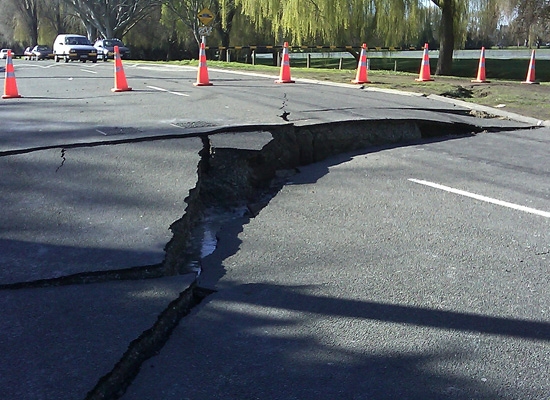
By Janine Starks* Email

Another letter from my mail bag:
My inner city villa was red-stickered in September after the first quake. It has been approved for demolition as it is unsafe and we are still waiting for it to be pulled down. My insurer is saying I need to renew my premium. Why? The house is a pile of rubble. Also, once the building is demolished and I have not paid insurance for the year how do I pay the EQC levy to protect my land in case there is a quake between the time of demolition and when the rebuild starts?
The answer to this one won’t please you. In fact it will probably shock in parts. Once you demolish, there is no cover on bare land, so you are fully exposed to the risk of another earthquake damaging your section. Most people are completely unaware of this risk. One minute you have land-cover, the next minute it goes poof and disappears into thin air. The short story is this; no house, no EQC land cover.
EQC won't cover the full value of a section, but for most people, it’s a big relief to have eight metres on each side of the house and the driveway is covered. It’s paid for via the fire and earthquake levy tacked on the end of your home-policy.
Many people with badly damaged homes want to demolish as soon as possible. After all, it feels like action and progress. But if a new house is not yet designed or through the consent process, all this does is expose the homeowner to risk on their land for a longer period.
Originally EQC told me they thought the land cover ceased when they paid out for the total loss on the home (the $100,000 payment). But once they double checked, it was confirmed as the point of demolition. Even a wrecked house on the section keeps the land cover in place.
If another quake strikes in the gap you will have to pay to remediate the section yourself, or walk away from it if it can’t be fixed. Even if you try and get clever and keep a home-policy in place after demolition (so the levy is paid), EQC tell me there is no cover.
|
Reasons not to cancel your insurance policy After chats with both VERO and AMI, here is a list of reasons not to cancel your insurance policy: 1. EQC cover on land: if your land wasn’t damaged, you need to keep paying your premiums to ensure you are protected against future quakes. Ironically, this land-protection doesn’t apply to those hit the hardest – the people who have to rebuild. On the day you demolish your home, your land protection goes up in smoke. It won’t be reinstated until a new house is in place. This leaves a gap where EQC won’t cover any damage to your land. 2. If you are paying monthly instalments: you must keep paying in full, until your policy comes to its annual renewal date. In order to make a claim, you need to honour your side of the bargain and pay for the full year. 3. You could be eligible for a discount, on renewal: Vero are giving customers 50 percent off the insurance bill, if their home is 75 percent damaged. They’ve had this in place since February. Ask your insurer, as discounts are case-by-case and won’t be automatically offered up. 4. An undamaged part of the building: it’s possible part of your house may remain. This needs to stay insured, in case aftershocks damage it. 5. Fences, driveways and pools: even with a full rebuild, you may have an undamaged fence, drive or pool. These need to stay insured. 6. Accidental damage to another property: If your house causes damage to a neighbouring property while it’s in an unsafe condition and awaiting demolition, you’ll need cover for that risk. 7. Home contents policy: your insurer may be paying for storage costs, but you need to pay the insurance bill. You may be able to lower your level of cover, but don’t forget to increase it again when you replace broken items. |
As a homeowner, you have not chosen to have bare land. It is simply the consequence of an insurance claim and remedy. Personally, I find this substantially different to someone who sets out to buy bare land and has full knowledge from the beginning that they are exposed to natural disasters. The situation feels wrong and affects those who were the hardest hit in the earthquake.
It seems absurd that the insurance process itself triggers a period where there is a transfer of risk from EQC back to a homeowner. The homeowner is forced to take on the very risk they had insured against. It leaves me shaking my head. As if people haven’t had enough to worry about, you now lose sleep wondering if another quake will hit during your rebuild project. It’s about as enjoyable as a game of Russian roulette.
I realise it is not EQCs fault that the legislation works in this way. Sometimes it is not until legislation is put to the test in a large natural disaster that the quirks show up. The severity of second, third or fourth events after a major earthquake was probably never anticipated. But as we all now know these risks are not minimal and there will soon be plenty of bare sections in Canterbury with no land cover.
When does EQC reinstate your land cover?
Once your new home is rebuilt, you can take out a home-policy with your insurer. As soon as this is in place, the fire and earthquake levy will be charged and your land protection is reinstated (your builder’s policy doesn’t cover your land).
Not until that point, can you stop holding your breath. Exactly when can you reinsure? Tricky question. VERO tell me it’s when the insurer deems the house is habitable. Different insurers could judge that point in different ways. I’d be calling as soon as the roof and windows were in.
Three scenarios to be aware of
Situation 1: major damage to part of your home, but no land damage. A second quake hits causing liquefaction or a major slip on your land.
- You continued paying your insurance premiums, as part of your home remained on the land. The EQC levy was paid as part of the policy.
- By virtue of part of the house still being in place, your land protection via EQC stayed in place and you are eligible for compensation for the damage caused by the second quake.
Situation 2: major damage to your entire house, but no land damage. The house is demolished, but a second quake hits causing liquefaction or a major slip on your land.
- You keep a home-policy in place, because there is an undamaged driveway and fencing, which needs ongoing protection.
- Despite having a policy in place, there is no cover on the section when the second quake hits, as the house was fully demolished. You are forced to remediate at your own expense or suffer a full loss on the land if it can’t be fixed.
Situation 3: major damage to your home and land. The house requires a full rebuild and the land can’t be fixed. EQC make a cash settlement on the land and you buy a new smaller section. A second earthquake hits and your new section liquefies.
- The money EQC gave you to buy a new section is now lost and there is no recourse (as there is no cover on bare land). You have to wear the cost of remediation or suffer the loss if it can’t be fixed.
- Alternatively, you take your combined payouts from EQC and the insurer and buy an existing house. Land cover is automatically in place because the section has a house on it. When the second event strikes, you have land cover and this limits your losses.
Have a question for Janine? Email her at starkadvice@gmail.com, subject line: Financial Agony Aunt. Anonymity is guaranteed.
*Janine Starks is Co-Managing Director of Liontamer Investments. Opinions in this column represent her personal views and are not made on behalf of Liontamer. These opinions are general in nature and are not a recommendation, opinion or guidance to any individuals in relation to acquiring or disposing of a financial product. Readers should not rely on these opinions and should always seek specific independent financial advice appropriate to their own individual circumstances.
2 Comments
When I built my own house back in the late 90's I was able to get insurance to cover the building while it was under construction. I would be surprised if most insurance companies did not offer this sort of cover, afterall the most vulnerable time for a house is when the bare framing is not protected by any sort of cladding. But the time the roof is on there is a fairly substantial amount of capital tied up in the building.
You missed
4. You take the $ and move to OZ, or another city at least...
regards
We welcome your comments below. If you are not already registered, please register to comment
Remember we welcome robust, respectful and insightful debate. We don't welcome abusive or defamatory comments and will de-register those repeatedly making such comments. Our current comment policy is here.